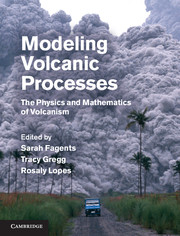Book contents
- Frontmatter
- Contents
- Contributors
- Chapter 1 Introduction
- Chapter 2 Magma chamber dynamics and thermodynamics
- Chapter 3 The dynamics of dike propagation
- Chapter 4 Dynamics of magma ascent in the volcanic conduit
- Chapter 5 Lava flows
- Chapter 6 Unsteady explosive activity
- Chapter 7 Unsteady explosive activity
- Chapter 8 Sustained explosive activity
- Chapter 9 Modeling tephra sedimentation from volcanic plumes
- Chapter 10 Pyroclastic density currents
- Chapter 11 Magma–water interactions
- Chapter 12 Deep-sea eruptions
- Chapter 13 Volcano–ice interactions
- Chapter 14 Modeling lahar behavior and hazards
- Chapter 15 Introduction to quantitative volcano seismology
- Chapter 16 Volcano acoustics
- Chapter 17 Planetary volcanism
- Index
- Plate section
- References
Chapter 6 - Unsteady explosive activity
Strombolian eruptions
Published online by Cambridge University Press: 05 March 2013
- Frontmatter
- Contents
- Contributors
- Chapter 1 Introduction
- Chapter 2 Magma chamber dynamics and thermodynamics
- Chapter 3 The dynamics of dike propagation
- Chapter 4 Dynamics of magma ascent in the volcanic conduit
- Chapter 5 Lava flows
- Chapter 6 Unsteady explosive activity
- Chapter 7 Unsteady explosive activity
- Chapter 8 Sustained explosive activity
- Chapter 9 Modeling tephra sedimentation from volcanic plumes
- Chapter 10 Pyroclastic density currents
- Chapter 11 Magma–water interactions
- Chapter 12 Deep-sea eruptions
- Chapter 13 Volcano–ice interactions
- Chapter 14 Modeling lahar behavior and hazards
- Chapter 15 Introduction to quantitative volcano seismology
- Chapter 16 Volcano acoustics
- Chapter 17 Planetary volcanism
- Index
- Plate section
- References
Summary
Overview
During strombolian eruptions, large bubbles of exsolved magmatic gas, with sizes of meters or more, intermittently burst at the magma surface, spraying magma clots over distances of tens to hundreds of meters. This style of activity results from low magma viscosities allowing gas bubbles to move through the liquid magma phase. Relatively small bubbles rise and coalesce into bubbles with diameters similar to that of the conduit, at which point they are called gas slugs. This coalescence is responsible for converting the continuous degassing processes at depth into the observed intermittent surface activity, and may be controlled by the decompression expansion of the bubbles or by portions of non-vertical conduit geometry. Models of strombolian systems cover the bubble coalescence phase (slug generation), the slug ascent, and finally slug burst and the ejection of pyroclasts. A wide range of geophysical measurements, notably from Stromboli and Erebus volcanoes, are available to test these subsurface models. Nevertheless, key questions, such as the degree to which the activity is controlled by the geometry of the conduit, remain.
Introduction
At volcanoes with relatively low-viscosity magmas such as basalt and basaltic andesite, large bubbles (with sizes of meters or greater) of exsolved gas can ascend rapidly through the melt and burst energetically at the surface, producing sprays of molten pyroclasts (Fig. 6.1). This type of intermittent explosion, in which a limited amount of magma is erupted with a relatively significant mass of gas, is known as “strombolian” after the characteristic activity at Stromboli volcano, where several such events usually occur every hour.
- Type
- Chapter
- Information
- Modeling Volcanic ProcessesThe Physics and Mathematics of Volcanism, pp. 107 - 128Publisher: Cambridge University PressPrint publication year: 2013
References
- 8
- Cited by



